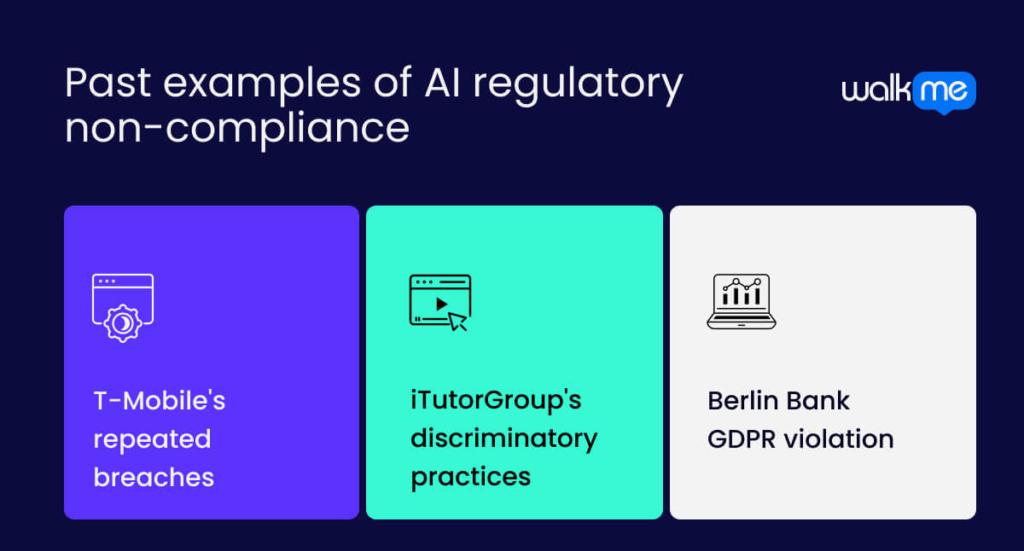AI adoption is changing business operations, particularly in HR and decision-making. It enhances employee productivity, accuracy, and innovation.
But, research shows many companies are unaware of AI regulations, even among early adopters.
While AI has many benefits, it also brings new risks. Companies must ensure their AI use complies with AI legal standards and ethical practices.
This article explains AI regulatory compliance and why it matters, outlines examples of non-compliance and the regulatory landscape, and introduces international standards and ways to ensure AI regulatory compliance in your organization.
What is AI regulatory compliance?
AI regulatory compliance is the process of following rules for using AI. This includes protecting people’s data, using AI fairly, and being open about how AI works. Companies must take responsibility for how AI is used and keep records of what they do.
Why is AI regulatory compliance important?
Traditional compliance methods have drawbacks. Reading long regulatory texts is slow and error-prone. Manual tracking can cause inefficiencies and missed deadlines. These issues grow as regulations become more complex.
AI in regulatory compliance is important because it:
- Ensures AI is used legally and ethically, protecting people’s lives.
- Safeguards privacy and security by handling personal data properly and enhancing cybersecurity.
- Improves internal controls, integrates legacy systems, and helps identify weaknesses to cut costs.
- Builds trust with stakeholders, as non-compliance harms a company’s image.
- Keeps organizations updated on regulatory changes, helping financial institutions reduce the risk of fines.
Key legislation for the AI regulatory landscape
Since AI is still a new field, laws around it are still developing. Regulators are working to balance innovation with ethical standards and public safety.
Below are the main examples of AI-related laws impacting the United States, Canada, the European Union and India:
US
In the United States, there is no single federal AI law. However, various guidelines and laws address different aspects of AI. For instance, the Executive Order on Safe AI Development guides federal agencies in creating AI responsibly.
It emphasizes safety, ethics, consumer protection, and civil rights. The AI Bill of Rights Blueprint lists principles to prevent algorithmic discrimination, protect privacy, and ensure AI transparency.
Several federal laws include AI provisions, such as the National Defense Authorization Act and the FAA Reauthorization Act. The National AI Initiative Act of 2020 promotes AI research to keep the U.S. competitive.
The AI in Government Act of 2020 also supports responsible AI in federal agencies. It creates an AI Center of Excellence, identifies workforce needs, and fosters collaboration on AI strategy. Agencies like the FTC and the Department of Commerce provide guidance for fair and transparent AI practices.
Canada
Canada supports responsible AI through initiatives like the Pan-Canadian AI Strategy and the Canadian AI Ethics Council. Its Personal Information Protection and Electronic Documents Act (PIPEDA) requires AI to meet strict data protection standards to ensure user privacy.
EU
The EU’s main regulation for AI is the EU AI Act. Other key laws include the General Data Protection Regulation (GDPR), the Product Liability Directive, the General Product Safety Regulation, and various intellectual property laws within EU Member States.
The EU AI Act sets rules for AI governance, compliance, and risk management. It classifies AI systems based on risk levels and assigns responsibilities to developers of high-risk AI. It also bans certain high-risk applications and requires transparency and accountability to protect users.
India
India’s Digital Personal Data Protection Act (DPDP), passed in 2023, updates the country’s data laws. It sets standards for handling personal data and gives people right to access and correct their data. The DPDP also mandates explicit consent for data collection.
The Data Protection Authority of India handles enforcement and can impose penalties for violations. The law requires companies to provide a grievance redressal process for people with data-related concerns. It applies to organizations collecting data from Indian residents and some international entities.
What are the international standards for AI regulatory compliance?
The International Standards Organization (ISO) creates rules for businesses to follow, including for AI. These rules help companies use AI fairly and ethically.
In late 2023, ISO released a new standard for managing AI. This standard helps companies create and maintain good AI systems. It ensures that companies have clear rules and plans for using AI.
This standard can be used by any company that develops, sells, or uses AI. It helps companies manage risks and meet the needs of their customers. It also helps different AI systems work together.
While following this standard isn’t required, it’s a good way for companies to show they care about using AI responsibly. Other countries, like the US, are also creating similar rules and guidelines for AI.
Past examples of AI regulatory non-compliance

Notable AI data security breaches highlight the need for strong security measures.
Here are key examples of failures in AI regulatory compliance:
Yum! Brands ransomware attack
In January 2023, Yum! Brands suffered a ransomware attack. The breach exposed corporate and employee data. The AI-driven attack targeted valuable information, forcing nearly 300 UK branches to close for weeks.
T-Mobile’s repeated breaches
T-Mobile faced its ninth data breach in five years in November 2022. Hackers stole 37 million customer records using an AI-equipped API and accessed sensitive information, including names, contact numbers, and PINs.
In July 2023, T-Mobile agreed to pay customers $350 million after revealing that their Social Security numbers and driver’s license details had been compromised. Nearly 80 million people in the U.S. were affected.
iTutorGroup’s discriminatory practices
In August 2023, the US EEOC settled a case against iTutorGroup. The company was fined $365,000 for using an AI recruitment tool that discriminated based on age. This marked the first U.S. settlement regarding AI-driven hiring tools.
The company violated the Age Discrimination in Employment Act by rejecting over 200 qualified applicants based solely on their age. As part of the settlement, iTutorGroup cannot use algorithms that reject candidates over 40 or discriminate by sex. They must follow non-discrimination laws and work with the EEOC to prevent future issues.
Berlin Bank GDPR violation
The Berlin Data Protection Authority fined a Berlin bank in 2023. The bank failed to inform a candidate why their online credit card application was rejected. Without this information, the candidate could not effectively challenge the decision. The bank violated several GDPR articles on automated decision-making and the right to access personal data.
How to ensure AI regulatory compliance

The key practical steps organizations need to implement effective AI compliance frameworks are:
Establish a compliance team
The first step in AI regulatory compliance is building a cross-functional team to handle the complex process. This team should include people from different areas, such as law, IT, data, and ethics.
A good team needs people with different skills. Lawyers understand the rules, data scientists know about AI, and ethicists focus on the moral side of AI. Together, they can make sure AI is used correctly.
It’s important to be clear about who does what. Lawyers provide legal advice, data scientists check AI systems, and ethicists make sure AI is used ethically. This team sets the foundation for a strong AI compliance system.
Conduct regular audits
Companies need to monitor and audit AI systems regularly to ensure they work correctly. This helps ensure they follow ethical and legal rules and don’t cause problems.
Regular checks make companies more accountable, transparent, and trustworthy. Monitoring also helps AI systems work better, helping them adhere to new rules and adapt to what customers, regulators, and society want.
Companies can take several steps to create a good AI monitoring program. First, they can create a special team to regularly check how AI systems are designed, developed, used, and maintained. This team should report on their findings and suggest improvements.
Companies can also create tools and metrics to track how well AI systems are working. These tools should be able to quickly find and report problems. Feedback from users, customers, and other stakeholders is also important. This feedback helps assess how well the AI system is working.
Clear documentation is key. Companies should report on AI activities and share this information with the right people. They should also review and update their AI rules and guidelines regularly, ensuring everything aligns with the company’s goals, values, and legal requirements.
Develop a compliance training program
To create a culture of responsible AI, companies need to make sure all employees understand AI.
This helps people understand how to use AI safely, ethically, and effectively. It also helps them understand the benefits and risks of AI and how to handle data properly.
Ongoing employee training is important to keep people up-to-date on AI and encourage responsible behavior.
In addition to general AI training, training tailored to specific roles can help people understand how AI affects their work.
Employees should also stay updated on the latest AI developments and compliance trends. Resources like webinars, online courses, and industry news can help.
Implement robust data governance practices
To ensure good governance, companies must keep updating their rules as technology and laws change.
A good starting point is to have clear rules about data. This includes who owns the data, how it can be used, and how to keep it accurate. These rules help companies use AI ethically and follow the law.
Protecting data is crucial. This means using strong AI security measures like encryption and access controls.
AI systems also face cyber threats. Companies need to be proactive in protecting their AI systems. This includes regular security checks, finding and fixing vulnerabilities, and adding strong security measures to every step of AI development.
Foster a culture of compliance
To make AI work well, everyone in the company needs to understand the rules. If people don’t follow the rules, the system won’t work.
It’s important to create an organizational culture where people care about using AI responsibly. Everyone needs to know why it’s important, the risks, and how they can help.
Clear communication is key. People need to understand the goals, the rules, and their role in using AI correctly.
Keeping good records is also important. This helps with accountability and makes it easier to answer questions from auditors. It’s also important to keep track of changes to AI models, rules, and processes.
Mitigate risk and encourage innovation with AI regulatory compliance
Companies need to follow AI rules to use it safely and legally. This helps protect people’s data and builds trust.
Not following these rules can be very expensive. Many big companies have been fined, and more rules are coming, so companies need to start planning now.
To prepare, companies should establish rules for using AI. They could hire a special person to lead AI efforts or create a team of experts.
It’s important to understand how AI is used, set clear goals, and find potential problems. AI should be easy to understand and regularly checked.
FAQs
Examples of certifications for AI regulatory compliance include:
- Risk Management Society (RIMS)’s Optimizing Risk Management With Artificial Intelligence
- Certified Information Security (CIS)’s Certified NIST Artificial Intelligence Risk Management Framework 1.0 Architect
- Global Association of Risk Professionals’s Risk and AI (RAI) Certificate
Some examples of AI regulatory compliance tools are:
- Compliance.AI
- SAS Compliance Solutions
- Kount
- Grand
- Fluxguard
AI regulatory compliance tools can analyze data to find patterns. They can automate tasks and keep rules up-to-date, helping teams work faster and avoid fines.

